Qualcomm bullish on automotive, AI on smartphones

CEO Cristiano Amon expects on-device AI to “drive competitive differentiation†in multiple verticals
Qualcomm saw its fourth consecutive quarter of record revenues in its automotive business and its executives including CEO Cristiano Amon were enthusiastic about the opportunities for the chip company that artificial intelligence, and particularly generative AI, are bringing as the use of AI spreads.
The company saw revenues of nearly $9.4 billion for the quarter, up 11% year-on-year. Net income was up 18% from the same period in 2023, to $2.1 billion. Qualcomm’s handset-related revenues (its largest segment) grew 12% from the second quarter of 2023, IoT revenues were down 8% and its automotive-related revenues jumped 87% year-over-year.
Cristiano Amon, Qualcomm president and CEO, said on the quarterly call with analysts that in automotive, Qualcomm is seeing “signs of the pipeline translating into revenue. … Just within the quarter, we have not only the launch of 10 new models with our technology, but also we actually have 10 new design wins, which continue to add to the pipeline,†he explained. “So we’re very excited about that. We will continue to see as new cars get launched with our technology from the pipeline, the revenue to grow.â€
He also said that gen AI use cases are manifesting in automotive, particularly for things like the use of large language models (LLMs) in audio. “We’re starting to see a lot of interesting use case being developed,†Amon said, adding that Qualcomm will be able to support “an upgrade of content in the digital cockpits†via AI.
Qualcomm also anticipates more growth in the use of AI on smartphones and PCs. “We’re pleased with the growth and trajectory of AI use cases on smartphones. This continued expansion of AI features is a precursor to next-generation smartphones which we believe will become AI-centric with pervasive on-device AI working across applications in the cloud,†Amon said, adding that “Qualcomm is very well-positioned to help drive this transformation across the industry in the coming years.â€
He said that AI features are creeping toward critical mass. There are now “tens†of such features, Amon said. “When they get to 100, we’re going to start to see a change, that a smartphone with AI feature will become an AI smartphone†which “could create an interesting upside if we have an AI-driven upgrade cycle. It’s still early in the process, but the use cases are becoming more interesting.â€
Overall, he continued, AI is “going to be a very important part of the human-computer interface. And this is going to start to change a lot of the user experience on apps.†He later added: “Eventually, a lot of the models are going to have multiple functionality across multiple apps.: Amon went on to compare the trajectory of AI with the trajectory of the smartphone: “First, there were like 10 apps, and then [it] became 100 apps and became 1,000 … apps, became hundreds of thousands of apps. And then it became very clear what was happening. I think we look at a little bit the same way,†he concluded. “We’re in the beginning, but we like the number of use cases increasing.â€
He also said that Qualcomm expects on-device AI to “drive competitive differentiation†for the company in industrial, networking and XR contexts along with handsets, PCs and automotive. As a result, Amon said that Qualcomm is “completely redesigning our industrial road map†and would unveil that in the coming months.
“We’re super-focused on growth and diversification, and it’s about a number of bets, not just one bet,†he added.
Qualcomm execs did note that its license to export products to Huawei, which was supposed to expire late this year, instead was revoked in early May, which will impact its revenues in this quarter and the next.

Comments are closed.